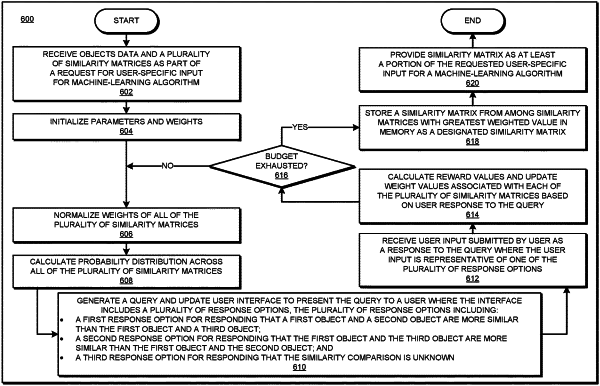| CPC G06N 20/00 (2019.01) [G06F 16/243 (2019.01); G06F 18/217 (2023.01); G06F 18/22 (2023.01); G06F 40/205 (2020.01)] | 18 Claims |

|
1. A computer-implemented method comprising:
initializing a budget value for iterative generation of a number of unique queries, the unique queries comprising respective unique query sets of objects;
generating a query prompting a user to select from among a plurality of response options related to a first query set of objects,
wherein the first query set of objects are from object data that is representative of a plurality of objects;
displaying the query to the user via a graphical user interface (GUI);
receiving, responsive to the query, user input via the GUI, the user input representative of a selected response option selected by the user from among the plurality of response options;
calculating, responsive to the user input, a plurality of weight values via a reward strategy for respective ones of a plurality of similarity matrices based on the selected response option, wherein the reward strategy comprises increasing the weight values based on a number of similarity matrices that agree with the selected response option,
wherein the plurality of similarity matrices include respective different sets of similarity values, each set of similarity values comprising similarity values representative of similarities of respective pairs of the plurality of objects;
repeating the generating of the query for a number of iterations that does not exceed the budget value, each iteration comprising prompting the user with respective unique query sets of objects; and
storing, on a selected storage medium, a designated similarity matrix from among the plurality of similarity matrices, the designated similarity matrix being designated from among the plurality of similarity matrices based at least in part on a highest weight value from among the plurality of weight values assigned to the designated similarity matrix.
|